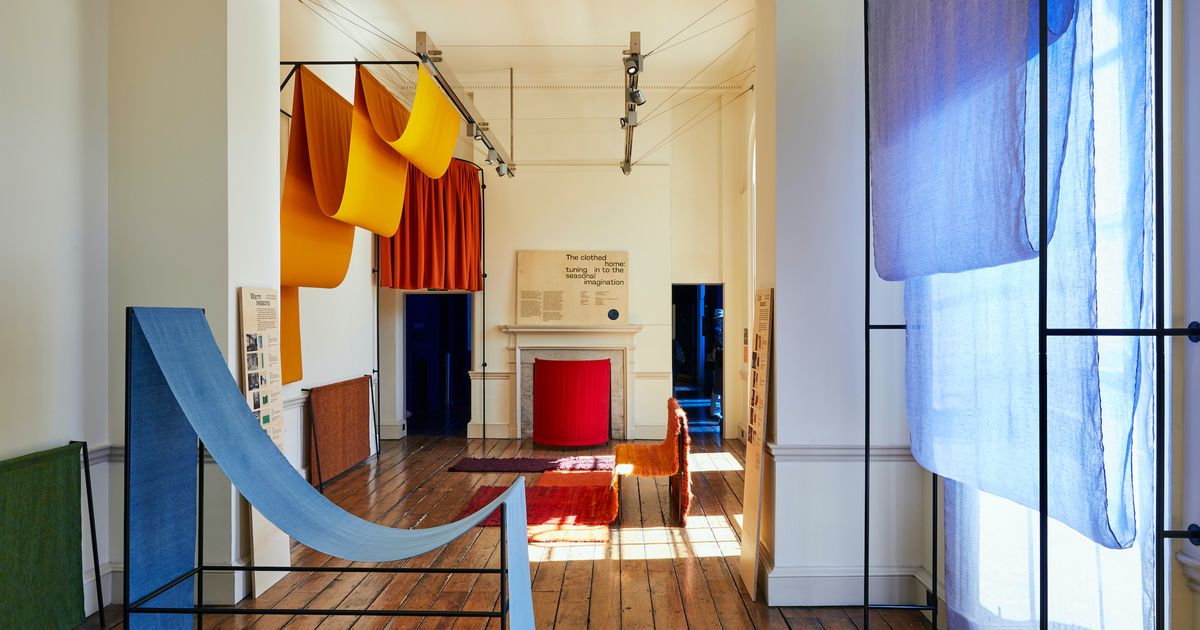Starting this August, the Adam Mickiewicz Institute (IAM), along with several Korean institutions—Seoul Museum of Craft Art, Jeonnam Ink Biennale, Cheongju Craft Biennale, Cinematheque, and Korea Foundation—co-organizes a series of cultural events on the verge of visual arts, design, architecture, showcasing Polish artists.
The Clothed Home. Korea–Poland Textile Crafts Exhibition
August 26–October 19, 2025
Organized in collaboration with the Seoul Museum of Craft Art, the exhibition recalls the historical role of textiles in home interiors that helped humans adapt to seasonal transitions. This exhibition echoes the Polish exhibition The Clothed Home: Tuning in to the Seasonal Imagination, which explored how textiles used indoors once played an active role in mediating between the interior and the external world.
Composed of Polish and Korean sections that share a common philosophical foundation—a “reappraisal of discomfort”—the exhibition seeks to illuminate ways of living that are finely attuned to the rhythms of nature. It also aims to reveal how textiles—far from mere decorative elements—have long served as sensory mediators, bringing together people, space, and the environment.
The Korean-Polish exhibition originates from an exhibition created by CENTRALA, Alicja Bielawska and Aleksandra Kędziorek for the Polish pavilion at the London Design Biennale 2021, later shown in Krakow, Ljubljana, Vilnius and Lisbon, among other places.
The Seoul edition will bring together Polish and Korean traditions and will be enriched with new works of art, including a newly commissioned work by Korean artist Min-soo Kim.
Jeonnam Ink Biennale
August 29–October 31, 2025
Przemysław Jasielski is a visual artist working on the intersection of engineering, art, and science. Many of his projects oscillate around the contemporary art and science paradigm, which treats art as an experimental scientific practice, while science—as a contemporary art theory. He works with a range of technologies—from simple methods of using paper to construct architectural structures to complex artificial life-management systems. Work Remember(me), which was shown at Polish Pavilion at Gwangju Biennale 2024, will be presented this year at Jeonnam Ink Biennale is a large-scale, kinetic installation that explores the evolving relationship between humans and machines through a retro-futuristic lens. Using a hydraulic system to pump black liquid through grooves etched in plexiglass, the work gradually reveals dream-like images of factory workers inspired by archival materials from Warsaw’s FSO car factory and a 1978 documentary by Antoni Dzieduszycki. Blurring the boundaries between past and future, Jasielski’s lucidographic engravings depict cyborg-like figures that reflect on automation, the erasure of physical labor, and the transformation of human workers into mechanized components of capital. The installation becomes a poetic and critical meditation on technology, labor, and the mechanized visions of utopia embedded in industrial and media narratives.
Tatiana Wolska—Born in 1977 in Poland, Tatiana Wolska lives and works in Brussels (BE). She completed her degree at Villa Arson (FR) in 2007. Wolska uses humble, discarded materials to create sprawling biomorphic sculptures. Her works on paper are integral part of her practice. She was awarded a prestigious Salon de Montrouge prize in 2014, which led to the solo presentation of her works at Palais de Tokyo. Amongst the institutional exhibitions she took part in are Domaine de la Chamarande, Duchamp Art Center, Yvetot, Fondation Villa Datris, L’Isle-sur- la-Sorgue, Frac Centre-Val de Loire, Orléans, Les Tanneries, Amilly, Van Buuren Museum, Brussels, Fondation Boghossian, Brussels, Galerie de la Marine, Nice, FRAC Corse, FRAC PACA, Marseille.
Cheongju Craft Biennale
September 4–November 2, 2025
This year’s Cheongju Craft Biennale marks first in the history presence of Polish artists. The biennale’s artistic director selected:
Alicja Patanowska—visual artist, designer and ceramicist associated with Wrocław, Poznań and London. The Cheongju Craft Biennale with feature her works which were presented in the main lobby of the Justus Lipsius building of the Council of the European Union and European Council.
Beata Legierska—a master lace maker, specializing in koniakow lace. Her works are cahracterized by a high technical and artistic level. Legierska is a master of compostion, which has been noticed and awarded in lace-making competitions. Her works are in museums and also in private collections. She conducts demonstrations and handicraft workshops in making Koniakow lace
Justyna Smoleń—painter, sculpturer, installations creator. She has presented her art in many international exhibitions. Her works can be found in private collections and in the collections of state cultural institutions, such as the Lower Silesian Society for the Encouragement of Fine Arts in Wroclaw, MOCAK Museum of Contemporary Art in Krakow and Bunkier Sztuki in Krakow. Smoleń is currently working at the Academy of Fine Arts.
Marcin Rusak—artist and interdisciplinary designer engaged in ideas of value, ephemerality and aesthetics. Operating on a spectrum between decay and conservation, the artist creates works that represent changing notions of value and symbolize the passage of time. Permanent and timeless, or on the contrary, decaying under the pressure of external circumstances, the objects and materials created by the artist analyze the apparent stability of the world around us, questioning the overconsumption and overproduction of goods.
As a public institution, IAM works to ensure that Polish culture resonates far beyond the country’s borders. Our presence in the Republic of Korea is a story of trust and shared visions. For more than a decade, in collaboration with Korean institutions and partners, new relationships have been developed, and over time they have grown into joint activities. Over the past 12 years, the Adam Mickiewicz Institute has realized more than 250 cultural events and 40 study visits, which have spawned many artistic friendships and cross-cultural projects.
